Hospital Based Complex Clinical Care and Long Stay: 2017 census
Results from the Hospital Based Complex Clinical Care & Long Stay Census.
This document is part of a collection
1. Hospital Based Complex Clinical Care and Long Stay Patients
Number of HBCCC and Long Stay patients in Census
Overall, there were 1,884 Hospital Based Complex Clinical Care ( HBCCC) or Long Stay ( LS) patients at the March 2017 Census. Of these, 1,087 (58%) were receiving HBCCC and 797 (42%) were LS. LS is defined here as patients in hospital for at least 6 months but not in receipt of HBCCC.
Of the 1,884 HBCCC or LS patients, 1,485 (79%) were occupying a Mental Health, Learning Disability or Addiction Inpatient Bed in an NHS Scotland Facility, 314 patients (17%) were in a General Acute / Community Hospital NHS Scotland facility, while 85 patients (5%) were treated outwith NHS Scotland (e.g. Private hospitals or NHS facilities elsewhere in the UK). See table 1 for more detailed breakdown.
Table 1: Number of HBCCC and LS patients by Census part, 2017
| Inpatient Census, 2017 | All Patients | HBCCC Patients | LS Patients |
|---|---|---|---|
| Part 1: Mental Health Bed Census | 1,485 | 857 | 628 |
| Part 2: Out of Scotland NHS Placements | 85 | 39 | 46 |
| Part 3: HBCCC & LS (general acute) | 314 | 191 | 123 |
| All HBCCC / LS patients in Inpatient Census | 1,884 | 1,087 | 797 |
The totals presented in Table 1 include 17 patients in NHS Fife for whom further patient level information is not available. The remainder of this publication will deal with the 1,867 patients for whom patient level information is available. Of the 1,867 patients, 57% (1,070) were in receipt of HBCCC and 43% (797) were Long Stay ( LS) patients (who were not in receipt of HBCCC).
Age and Gender
Figure 1 shows the age and gender breakdown of patients receiving HBCCC at the March 2017 Census. Some key points include:
- Of the 1,070 patients, 605 (57%) were male, while 464 (43%) were female. Data was missing/unknown for 1 patient. Males represented 49% of the general Scottish population in 2016, suggesting males are over represented in HBCCC.
- Patients were mostly from the older age groups, 589 (55%) patients were aged 65 or over, while a further 289 (27%) were aged 40 – 64. There were 180 (17%) patients aged 18 – 39 and 11 (1%) patients under 18 receiving HBCCC at March 2017 Census.
- Gender differences described are strongly influenced by age. For patients aged under 40, 71% are male. Of those aged 40 – 64 years, 67% are male. This trend reverses for the 65 or over group where only 47% are male. This change will partly reflect the differing life expectancy of males (77.1 years, 2015) and females (81.2, 2015).
Figure 1: Number of patients receiving HBCCC, by age and gender, 2017

Figure 2 shows the age and gender breakdown of LS patients at the March 2017 Census. Some key points include:
- Of the 797 patients, 469 (59%) were male, while 328 (41%) were female. Males represented 49% of the general Scottish population in 2016, suggesting males are over represented.
- Patients were mostly from the older age groups, with 325 (41%) aged 40 – 64 years
a further 297 (37%) aged 65 or over. There were 163 (20%) LS patients aged 18 – 39 and 12 (2%) LS patients under 18 at March 2017 Census.
- Gender differences described are influenced by age. For patients aged under 40, 65% are male, while a similar proportion of patients aged 40 – 64 years, 64%, are male. The split for the 65 or over group is 50%. This change will partly reflect the differing life expectancy of males (77.1 years, 2015) and females (81.2, 2015).
Figure 2: Number of LS patients, by age and gender, 2017
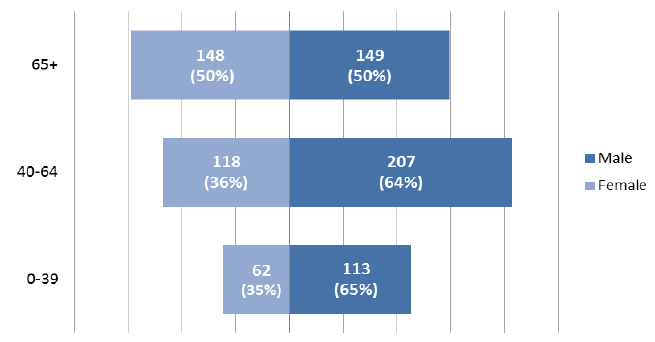
Ethnicity
The majority of HBCCC or LS patients at the 2017 Census date, for whom ethnicity was known, were of White Scottish ethnicity, 1,411(83%). A further 238 (14%) patients were of another White ethnicity. Information was not known or refused for 164 patients. See figure 3 for further details.
Figure 3: Number of HBCCC or LS patients by ethnicity, 2017
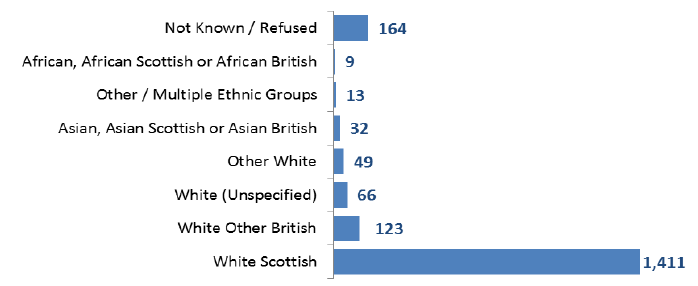
Consultant Specialty
As part of the Census, NHS Boards were asked to record the medical specialty of the consultants responsible for overseeing the treatment of each patient in the Census.
Of the 1,070 patients receiving HBCCC at the census, 389 (36%) had a consultant who specialised in Psychiatry Of Old Age, 268 (25%) had a consultant specialising in General Psychiatry and 165 (15%) in Forensic Psychiatry. See figure 4 for further details.
Figure 4: Number of patients receiving HBCCC by consultant specialty, 2017

¹ Other includes a range of specialties with smaller numbers that have been aggregated to protect patient confidentiality
Of the 797 LS patients at the Census, 269 (34%) had a consultant who specialised in General Psychiatry, 185 (23%) had a consultant specialising in Psychiatry of Old Age and 120 (15%) in Forensic Psychiatry. See figure 5 for further details.
Figure 5: Number of LS patients, by consultant specialty, 2017

¹ Other includes a range of specialties with smaller numbers that have been aggregated to protect patient confidentiality
* Data missing for 1 patient
NHS Board Breakdown
NHS Greater Glasgow & Clyde were responsible for funding the treatment of 337 HBCCC patients (31%), followed by NHS Lothian with 334 (31%). NHS Shetland had no patient in receipt of HBCCC. See figure 6 for further details.
Figure 6: Number of patients receiving HBCCC by Funding NHS Board, 2017

* Numbers have been suppressed to protect patient confidentiality
** National Services Division is funded by the territorial NHS Boards, and provides funding for a small number of patients in cases where they may require more specialized, long-term or cost-intensive treatment
*** 3 patients had unknown funding or no fixed abode
NHS Orkney had the highest rate of HBCCC patients at 59.5 per 100,000 population, though this will be influenced by the fact NHS Orkney has the lowest population of all the Health Boards. NHS Lothian (38.0) and NHS Greater Glasgow & Clyde (29.0) had the next highest rates. See figure 7 for further details.
Figure 7: Rate of HBCCC patients per 100,000 population, by Funding NHS Board, 2017
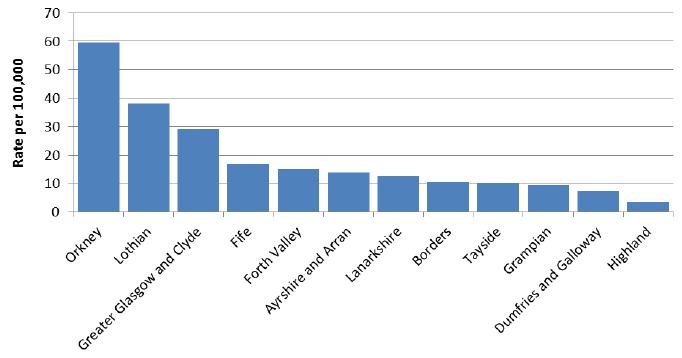
* Excludes Health Boards who have been suppressed to protect patient confidentiality
NHS Greater Glasgow & Clyde were responsible for funding the treatment of 252 LS patients (32%). NHS Lothian had the next highest number with 169 (21%). See figure 8 for further details.
Figure 8: Number of LS patients by Funding NHS Board, 2017
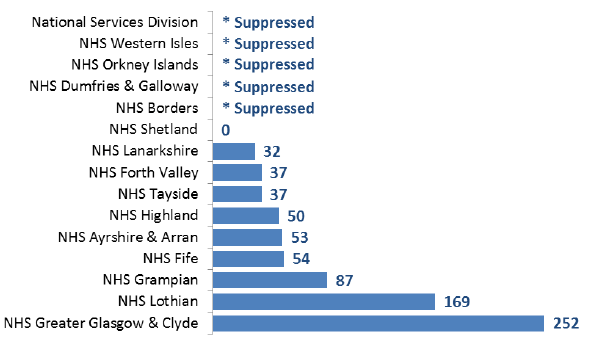
* Numbers have been suppressed to protect patient confidentiality
** National Services Division is funded by the territorial NHS Boards, and provides funding for a small number of patients in cases where they may require more specialized, long-term or cost-intensive treatment
NHS Greater Glasgow & Clyde had the highest rate of LS patients at 21.7, while NHS Lothian (19.2) had the next highest rate. See figure 9 for further details.
Figure 9: Rate of LS patients per 100,000 population, by Funding NHS Board, 2017
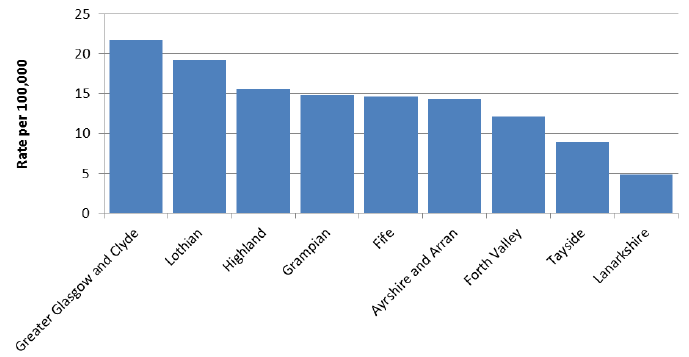
* Excludes Health Boards who have been suppressed to protect patient confidentiality
Local Authority Breakdown
Figure 10 provides analysis of patients in receipt of HBCCC by local authority of residence (based on the patient’s home postcode). Where a local authority has between 1-4 patients in receipt of HBCCC, the local authority has been grouped with another local authority with similar small numbers. This is to protect patient confidentiality. Edinburgh City had more HBCCC patients than any other Local Authority at the 2017 Census with 224 patients (21%). Glasgow City had the next highest number with 183 (17%).
Figure 10: Number of patients receiving HBCCC by LA of home post code, 2017
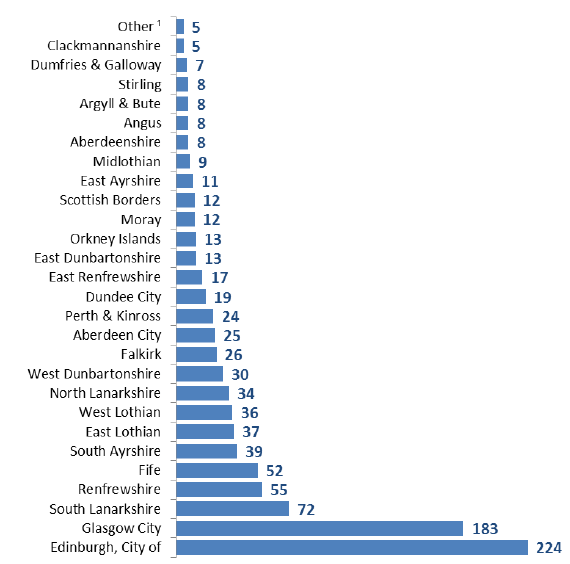
¹ Other includes Local Authorities with smaller numbers that have been aggregated to protect patient confidentiality
* Data unknown for 78 patients
Figure 11 provides analysis of LS patients by local authority of residence (based on the patient’s home postcode). As previously, where a local authority has between 1-4 LS patients, the local authority has been grouped with another local authority with similar small numbers. This is to protect patient confidentiality. Glasgow City had more LS patients than any other Local Authority at the 2017 Census with 123 patients (15%). Edinburgh City had the next highest number with 73 (9%).
Figure 11: Number of LS patients by LA of home post code, 2017
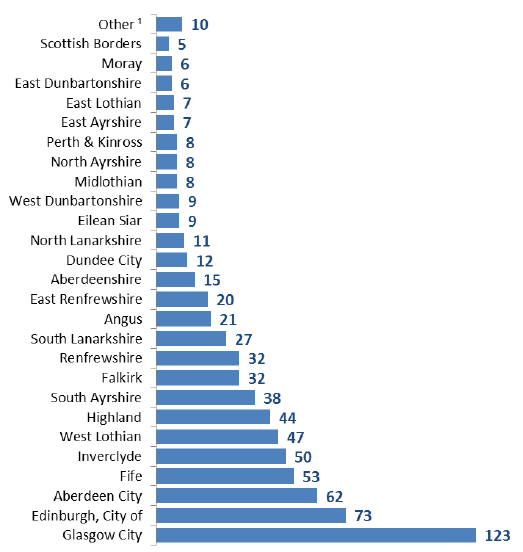
¹ Other includes Local Authorities with smaller numbers that have been aggregated to protect patient confidentiality
* Data unknown for 54 patients
Length of Stay in Hospital
NHS Boards were asked to record how long patients had been in hospital at the March 2017 Census date. The average (median) time in hospital for HBCCC patients was 575 days (approximately 1 year and 6 months). For LS patients, the average (median) time in hospital was 574 days (approximately 1 year and 6 months. The spread of length of stay for patients can be seen in Table 2.
Table 2: Length of Stay, HBCCC and LS patients, 2017
| Length of Stay | HBCCC Patients | LS Patients |
|---|---|---|
| Less than 6 months | 257 | 0 |
| At least 6 months, less than 1 year | 143 | 257 |
| At least 1 year, less than 3 years | 314 | 269 |
| At least 3 year, less than 5 years | 132 | 100 |
| 5 years or more | 223 | 168 |
| Median | 575 | 574 |
* Admission date unknown for 4 patients
Health Conditions
NHS Boards were asked to return information on any health conditions a patient had been diagnosed with. Figure 12 shows the top six conditions for HBCCC and LS patients at the 2017 March Census. The most prevalent was Mental Health with 891 (83%) HBCCC and 671 (84%) LS patients.
Figure 12: Health Conditions diagnoses, HBCCC and LS patients, 2017
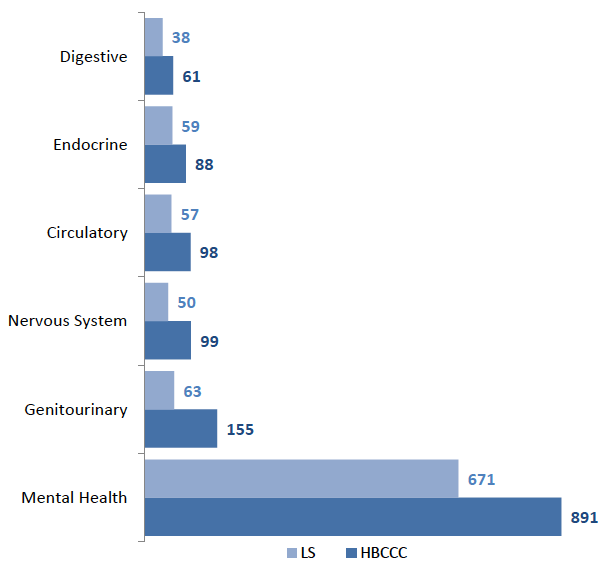
* Patients can have more than one condition
Contact
Phone: Central Enquiry Unit 0300 244 4000
The Scottish Government
St Andrew's House
Regent Road
Edinburgh
EH1 3DG
There is a problem
Thanks for your feedback